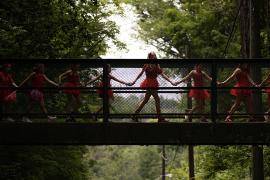A colleague recently asked whether her camp should have an AED (automated external defibrillator) on site. Just three or four years ago, I would have responded to that question with a resounding "No." My opinion has changed. "Maybe. . . ."
Remember when AEDs first came out? The units were expensive, training was inconsistent, and camp professionals wondered on what tree we'd place the device. In August 2004, the Association of Camp Nurses' publication, CompassPoint, examined the AED question from a point-counterpoint perspective. Googling the topic today triggers a deluge of information. To be most effective, it's still recommended that the device be within three to five minutes of an incident, but now more people — especially emergency response personnel like lifeguards — have been trained to use the device. Public opinion regarding access to this equipment is changing. As a result, my opinion is in a state of flux. I used to think that AEDs were unnecessary at most camps. I'm not sure I can say the same thing now. In all honesty, it depends.
In Support of Having an AED at Camp
Determining whether a camp should have on-site access to an AED means considering many points and, in so doing, deciding whether the point falls more strongly in the pro or con column for a given camp. For example, sudden cardiac arrest — the diagnosis that AEDs are best designed to help — is generally not common in the pediatric population. But today's camps have more than children at the facility. Staff ages range from collegiate to seniors, and expanded programming may include adult sessions, the very people who most benefit from an AED should a need arise. A camp that hosts adult programs may well determine it has greater likelihood of needing an AED than other camps; a camp that serves people with cardiac problems could reasonably anticipate needing an AED more than camps with noncardiac populations. Where does your camp profile fit?
Another factor is realizing that a few children and adults may come to camp with undetected cardiac anomalies. Camp's vigorous activity level, especially when compared to the couch-potato existence of some participants, can put additional stress on the cardiac system. If this system is already compromised by an anomaly, sudden cardiac arrest is a risk — the very risk designed to be helped by an AED. Now the question becomes one that considers the potential for cardiac stress from camp activities compared to the health profile of participants.
Next, I believe we're experiencing a gradual normalization of AEDs in our everyday worlds. Indeed, malls, airports, and a growing number of school districts now have the devices. In addition, AED training is part of the American Heart Association and American Red Cross basic life support curriculums. People have been exposed to the device and, given continued media attention, some may simply assume there's an AED at camp. Consider the people served by your program; might they have such an expectation? On the other hand, perhaps comment specifically about the scope of emergency equipment at camp should be part of pre-arrival information for all client groups. That would certainly clarify expectations.
There is a perception that having an AED places greater liability on the entity. Granted, the device must be maintained, periodic staff training is needed, and a physician's order supports the program. The National Center for Early Defibrillation (www.early-defib.org) tracks these legal issues. This organization notes that inclusion of AED training in basic life support courses indicates that the skill is no longer "advanced." There is some case law where entities have been held negligent for not having an AED. The opposite can also hold. Consequently, informed decision-makers might also bring the camp's legal counsel into this discussion.
There's a growing number of resources available to businesses that would like to initiate an AED program. The American Heart Association's Web site (www.americanheart.org) generated 167 articles when "AEDs" was placed in the site's search function and over 500 when "AED Public Policy Toolkit" was entered. Additionally, many Good Samaritan Laws have been amended to reduce both public and professional risks associated with using an AED during an incident. And the concept of Public Access Defibrillation is gaining popularity (another Google opportunity). Another resource can be local EMS providers; a few camps have partnered with these folks for training support.
Couple access to knowledge and an improved legal environment with a number of funding options for obtaining and setting up an AED program (Google "AED funding"). It's becoming more difficult to explain why an entity doesn't have an AED.
Why AEDs Should Not Be at Camp
So, what are some of the points that argue against having an AED, especially when there is growing public awareness about them and the idea of being unable to effectively revive the victim of sudden cardiac arrest at camp is overwhelming for many of us? The technology exists and could be made available. So why not have it?
First, the units should be reasonably accessible to the incident. Remember the earlier comment about placing an AED within three to five minutes of the incident? Given that many camps cover acres of territory, just where would the device go? Currently, AEDs are placed where there is a large number of people, primarily adults, present on a daily basis. Initial community placement models looked at habitual populations of 1,000 people or more. Many camps are seasonal and under that population count. Do your community playgrounds have an AED? Do recreational areas like bowling alleys have one? Do your schools? Churches, Synagogues? Do EMS responders travel with one? Is having an AED one of the criteria used by the school when taking students on overnight field trips (e.g., to environmental education centers)? Knowing the expectation regarding access to an AED tempered with the reality of where AEDs actually exist in communities is critical.
And yes, having an AED impacts the budget. In addition to purchasing the unit (or several), it must be maintained, protocols must be developed, staff must be trained and rehearsed. An AED clearly adds to the camp's budget. A balance must be struck. What's a good answer to this question for one camp may be very different for another. Another money factor, one that must be brought into the budget discussion, is that State and municipal initiatives make having an AED more possible in some locations of the country than in others. There's a current disparity over allocation of resources, making a blanket response to the funding question difficult. Some camps have talked with their local EMS folks to determine what's available in their area.
Also consider the safety measures already in place at camp. Are people — campers (clients) and staff — protected from reasonably anticipated hazards? Consider doing a safety audit, one that helps you prioritize risks (hint: talk with your insurance carrier). Based on that priority ranking, address risks and the safety elements that reduce or eliminate them in rank order. If cardiac risks rank high, consider an AED but also examine other strategies that minimize cardiac events, strategies like CPR-trained staff and effective screening of potential clients to minimize the risk of a cardiac event.
Finally, some camp programs simply don't lend themselves to having an AED at hand, programs such as canoe trips and backpacking through the mountains. I'm not aware of people carrying AEDs as part of the EMS equipment for these programs. Satellite phones, maybe. AEDS? Not yet. A review of the proceedings from Wilderness Risk Management Conferences to date have no mention of AEDs although other technologies like GPS devices and satellite phones have been discussed.
So What's a Camp to Do?
At minimum, the AED question is a moving target. Improved technology has made the device more reliable, reduced maintenance, made them more affordable and more portable. Couple these points with CPR curriculums that includes AED training, development of Public Access Defibrillation (American Heart Association, 2001; retrievable at www.americanheart/org/downloadable/
heartsmart/10957141855334Apadcase.pdf) and the glee with which people, including those who have health challenges, march into experiences. It's a strong argument for a camp to, at minimum, talk about what an AED might provide. And because the parameters that impact the AED question are changing, the conversation should be revisited every so often — with legal and insurance opinions in the discussion.
At present, it would be prudent to let clients know what emergency equipment is at camp. At most camps, the likelihood of needing an AED is minimal. But is it worth the risk not to have one?
Linda Ebner Erceg, R.N., M.S., P.H.N., is the health and safety coordinator for Concordia Language Villages and the executive director of the Association of Camp Nurses.
Originally published in the 2006 January/February issue of Camping Magazine.




